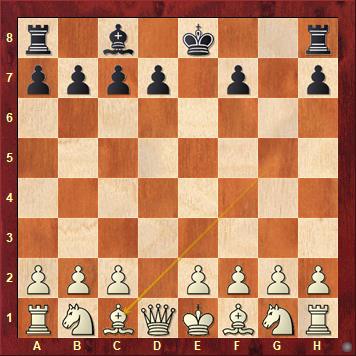
Newspaper article celebrating Werner Keym's eightieth birthday
To celebrate his eightieth birthday, on the palindromic day 22.02.2022, we brought you some puzzles from Werner Keym's book Anything but Average. The octogenarian specializes in problems involving castling, en passant captures and pawn promotion. Here, today, are the solutions to the unusual and often whimsical problems.
The above problem was composed 56 years ago and appeared in the Allgemeine Zeitung Mainz. The position is truly symmetrical, and for any key move, White should have a mirror move on the other side. So there were two questions: how can White secure a draw in the above position; and why does the mirror solution not work?
Solution: 1.Be4! Foreplan for the purpose of opening the line e4-h1.
Thematic try: 1.Bg4? Rf4 2.Bxh3 d2 3.Bg4 Rxg4 4.Ke2 Rg2 5. Kd1 Rxf2–+; 1.Bxd3? h2 2.Kg2 Rxf2+ 3.Kh1 (3.Kxf2 h1=Q–+) 3...Ke5 4.Bg6 Kf4 5.Be4 Kg3 6.Bg2 Rd2 7.Bf1 Rc2 8.Bg2 Rc1+ 9.Bf1 Rxf1#; 1.Bxh3? d2 2.Ke2 Rxf2+ 3.Kd1 (3.Kxf2 d1=Q–+) 3...Ke5 4.Bd7 Ke4 5.Bg4 Ke3 6.Bh5 Rf5 7.Be2 Rc5 8.Bg4
1...Rf4 2.Bxd3 h2 3.Be4 Rxe4 4.Kg2 Re2 5.Kh1 Rxf2 Stalemate. (5... Kf5 6.Bg3 Kg4 7.Bxh2 Kh3 8.Bg1=).
For the unique problem, which made all four castlings an integral part of the solution, we provided all moves in a replayer. For anyone who missed it, here it is again:
The next was a fairly insidious problem:
You will not be able to mate in three unless you play the correct key move. To find it you should look at the position carefully – and think out of the box! There are five tries, each with precisely one refutation:
1.Ra8? bxa4!
1.Bxb5+? Kxd8!
1.Nb6+? Kxe8!
1. Ncd6? bxa4!
1.Ned6? Kxd8!
However, this is a retro problem with a well-concealed key. The last move must be bPb7-b5, before which the white rook moved from c6 to a6, capturing a black piece on a6 and delivering the discovered bishop check. So the en passant capture is allowed, and the solution is 1.axb6+! Kxd8 (1...Kxc8 2.Ra8+ Kb7 3.Bc6#) 2.b7 g6 3.Rd6#.
The next problem was a "proof game": you were asked to start from the initial position and reach the position below after White's seventh move:

Solution: 1.d4 Nh6 2.Bxh6 g5 3.Bxf8 Nc6 4.Bxe7 Nxd4 5.Bxd8 Nb3 6.Bxg5 Nc1 7.Bxc1. You can try to do so on the following diagram (where you can move pieces):
In similar vein, Werner Keym drew attention to these two historical king-only proof games:

Sam Loyd: proof game in 17 – François Labelle, proof game in 20
The first was published in 1895 by Sam Loyd. Starting from the initial position you should reach the position on the left (wKe2, bKe7) in 17 moves. Loyd's problem had multiple solutions, but at least the position displayed could not be reached in fewer moves. The proof game published in 2012 by the Canadian mathematical chess explorer François Labelle, after a monumental computer search, performed over eight years, is the first dualfree proof game resulting in bare kings! We don't want our readers spending the next years trying to solve these proof games, so we provided the solutions. You might at least enjoy playing through the "massacre games" that lead to the bare kings.

 Anything but Average (second edition), from which the above puzzles were taken, is a chess book aimed at all chess lovers: players and problemists. We quote from the preface:
Anything but Average (second edition), from which the above puzzles were taken, is a chess book aimed at all chess lovers: players and problemists. We quote from the preface:
Over-the-board chess and chess composition complement each other wonderfully: battle and art. A game is a struggle between two people, a composition is the product of an individual. A chess game lives from mistakes, the chess problem dies from them. A game perfectly played by both sides often leads to a colourless draw, a perfect chess composition is an everlasting source of pleasure. Anticipation or plagiarism is irrelevant for the chess player, for the chess composer it means bad luck or violation.
Details: www.berlinthema.de (including a 24-page excerpt)
Second edition (cloth-bound) 2021. 25 € + postage.
Order per e-mail: Ralf.Kraetschmer@t-online.de
Werner Keym specializes in
.jpeg)





















 Anything but Average (second edition), from which the above puzzles were taken, is a chess book aimed at all chess lovers: players and problemists. We quote from the preface:
Anything but Average (second edition), from which the above puzzles were taken, is a chess book aimed at all chess lovers: players and problemists. We quote from the preface:




